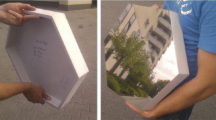Abstract
This paper summarizes recent advances on the Columbus Project telescope and in the University of Arizona Mirror Lab. The Columbus telescope structure has been re-optimized to allow rapid changes between foci, while still maintaining high rigidity. Room has been made to translate secondary and tertiary spiders out of the light path to the center. A bill allowing construction of the telescope on Mt. Graham, Arizona, has been passed by Congress and signed into law. Two alternative enclosure designs, one with a co-rotating building and a second which opens like a flower, are being explored.
A common baseline design for the 8 m honeycomb mirrors for both the Columbus and Magellan telescopes has been developed. It has stiffness comparable to that of the Palomar 200 inch mirror. The Mirror Lab has successfully cast two 3.5 m honeycomb blanks and expects to begin casting at the 6.5 and 8 m scale at the end of 1990. Interferometric tests of the Vatican f/1 1.8 m borosilicate honeycomb mirror show good stability of figure with the air jet ventilation system. A 60 cm stressed lap has been completed, and will be used to parabolize this mirror which is now polished as an f/1 sphere. Plans for a polishing facility to house two 8 m machines and a test tower are complete, with construction starting in April 1989.
Similar content being viewed by others
References
Ballio, G. and G. Parodi, “BCV Report # 112 to the Columbus Project,” 1988.
Cheng, A.Y.S. and J.R.P. Angel, “Thermal Stabilization of Honeycomb Mirrors”, Proceedings of ESO Conference on Very Large Telescopes and their Instrumentation, ed. M.-H. Ulrich (Garching, ESO), Volume I, pp. 467–477, 1988.
Davison, W. and J.R.P. Angel, “Enclosures that Fold Away,” Columbus Project Technical Memo, UA-89-1, 1988.
Epps, H.W., “Optical Subsystem Alternatives for the Columbus and Magellan Telescopes,” Mt. Wilson and Las Campanas Observatories, January 27, 1989.
Gallieni, W., R. Gatti and R. Villa, “Handling and Storing Problems of Instruments and Optics Supports in Columbus Building,” Proceedings of ESO Conference on Very Large Telescopes and their Instrumentation, ed. M.-H. Ulrich (Garching, ESO), Volume II pp. 889–895, 1988.
Lubliner, J. and J.E. Nelson, “Stressed Mirror Polishing. 1: A Technique for Producing Nonaxisymmetric Mirrors,”Applied Optics, Vol. 19, p. 2332, 1980.
Majorana, C., B. Schrefler, A. Vigilante, A. Zaupa, F. Zaupa and G. Zavarise, “Feasibility Study of the Elevation Structure, Static and Dynamic Analysis,” Columbus Project 2×8 m F 1.2 Optical Telescope, SIGE Report, 1988.
Martin, H. M., J.R.P. Angel, and A.Y.S. Cheng, “Use of an Actively Stressed Lap to Polish a 1.8 m f/1 Paraboloid,” Proceedings of ESO Conference on Very Large Telescopes and their Instrumentation,, ed, M.-H. Ulrich (Garching, ESO), Volume I, pp. 353–361, 1988.
Nelson, J.E., J. Lubliner, T.S. Mast, “Telescope Mirror Supports: Plate Deflections on Point Supports,” Proc. PulS.P.I.E., Vol. 332, p. 212, 1982.
Parodi, G., private communications, 1989
Author information
Authors and Affiliations
Rights and permissions
About this article
Cite this article
Angel, J.R.P., Hill, J.M., Martin, H.M. et al. Recent progress on the Columbus Project and the Miror Laboratory program. Astrophys Space Sci 160, 55–70 (1989). https://doi.org/10.1007/BF00642755
Received:
Issue Date:
DOI: https://doi.org/10.1007/BF00642755




